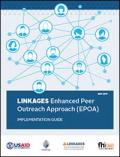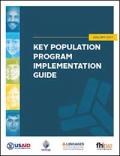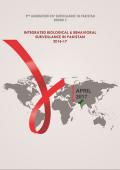Publications on Key Populations

Resource | Guidelines,
This guide introduces the enhanced peer outreach approach, which engages previously unidentified members of key populations for HIV prevention and testing, particularly those who are hard to reach and who may be at high risk or already have HIV. This guide describes the approach, its potential benefits and the steps involved in implementing it.

Resource | Tools,
The Programmatic Mapping Readiness Assessment Tool provides an adaptable step-by-step guide for conducting an mapping readiness assessment (MRA). The MRA focuses on the safety and well-being of KPs as a group and individuals within the group; helps identify the potential risks and benefits of conducting PM before initiating the mapping process; and guides discussions among program staff, steering committee members, and community leaders in creating an action plan to address risk.

Resource | Publications,
The report offers a window through which to gauge the approach and methodology of the Independent Expert. There are key reflections responding to the mandate, particularly regarding the panorama of the situation, including the implementation of international instruments, with identification of good practices and gaps.

Resource | Publications,
Three decades of experience in the global response to HIV show that human rights-based approaches to HIV prevention, treatment, care and support – coupled with enabling legal environments to safeguard rights – help reduce people’s vulnerability to HIV. A rights based response to HIV helps ensure that services are accessible to those most at risk, and enables key populations and other affected communities to participate in deciding an enabling legal and policy environment, which can also have a direct impact on reducing HIV transmission.

Resource | Guidelines,
These are the first WHO guidelines on testing for chronic HBV and HCV infection and complement published guidance by WHO on the prevention, care and treatment of chronic HCV and HBV infection. The primary audience for these guidelines are national programme managers in ministries of health and health-care providers in low- and middle-income countries (LMICs) responsible for planning and implementing hepatitis testing, prevention, care and treatment services.

Resource | Guidelines,
This implementation guide will be useful for LINKAGES staff members wherever the program is operating, and for organizations that implement the LINKAGES program at the local level ("on the ground"). Although the guide may help partners working with LINKAGES at the country level, such as Ministries of Health, the guide is designed for LINKAGES country programs.









